PART FOUR IN AN 11-PART SERIES. Read parts 1, 2, and 3. Milwaukee County’s criminal justice system has broken down at almost all levels. Although some of this can be attributed to the pandemic, all of it can not. Local officials’ questionable policy decisions and their failure to develop strategies to restore effectiveness also play a role, and it’s imperiling public safety.
PROBLEM #4: Milwaukee Police arrests for serious crimes (Part 1 offenses) have plummeted dramatically, dropping 36.8% from 2018 to 2022. For less serious crimes (called Part 2 offenses), they dropped a whopping 61% even though the # of offenses in those categories rose 26%. Arrests continued to fall in 2022, well past the pandemic’s height.
MPD arrests for vagrancy, liquor law violations, and disorderly conduct have screeched to a near complete halt; those are so-called “Broken Windows” quality-of-life offenses that used to be the hallmark of Milwaukee’s policing strategy (and New York’s to great success in the Bill Bratton era. That theory holds that cracking down on lower-level disorder offenses prevents larger crimes from occurring by restoring social order.)
Weapons violation arrests by MPD have dropped 53% since 2018. In many cases, “declines are not fully attributable to the pandemic.” Municipal citations for ordinance violations and juvenile infractions also dropped sharply.
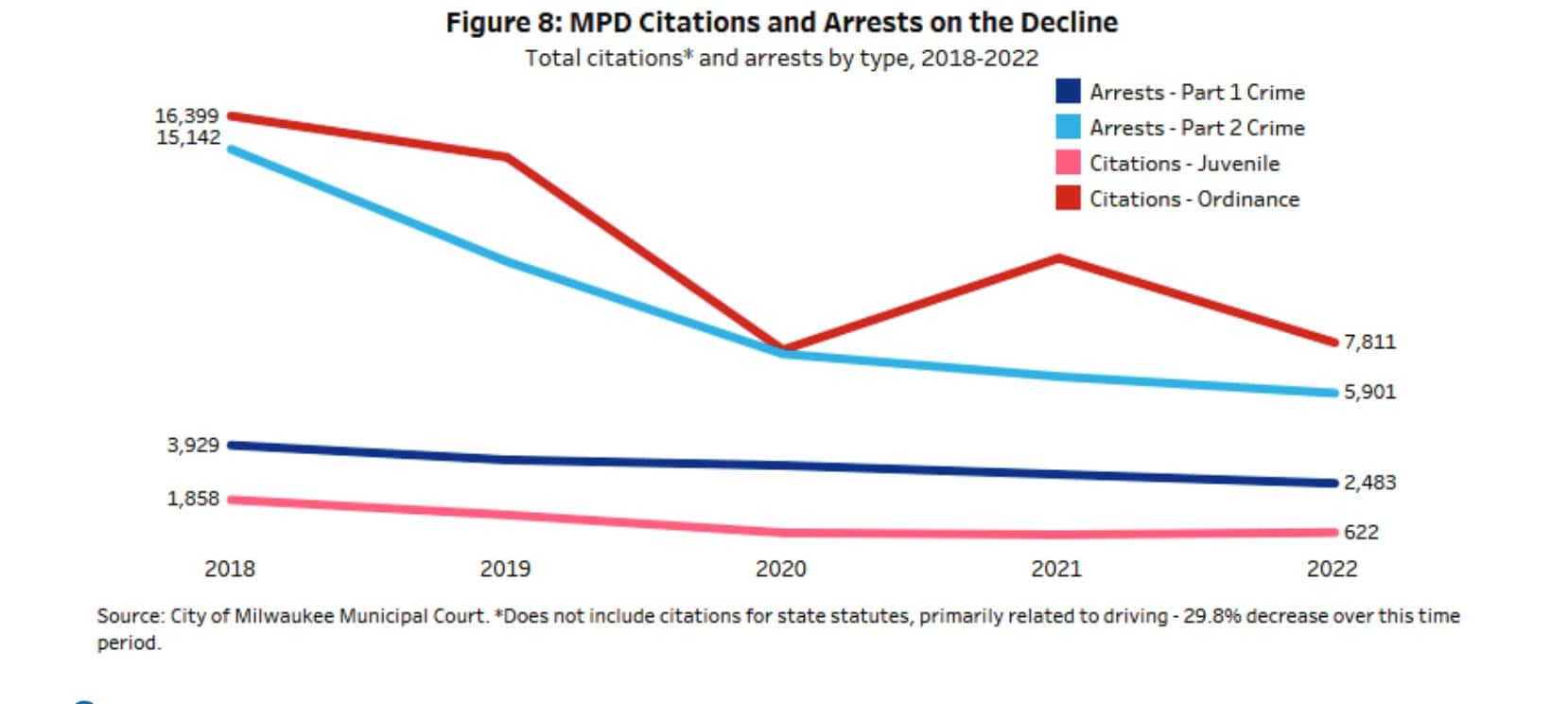
Some suburban agencies have started to recover statistically since the pandemic, but MPD has not. In the City of Milwaukee, larceny theft arrests have plunged. Clearance rates have dropped since 2018, driven by the extremely low number of motor vehicle thefts that are solved. In 2022, of the 10,872 motor vehicle thefts reported, only 895 resulted in arrest. MPD only cleared 15.2% of all offenses from 2018-2022. Clearance rates for murder and manslaughter dropped from 67% to 50%.
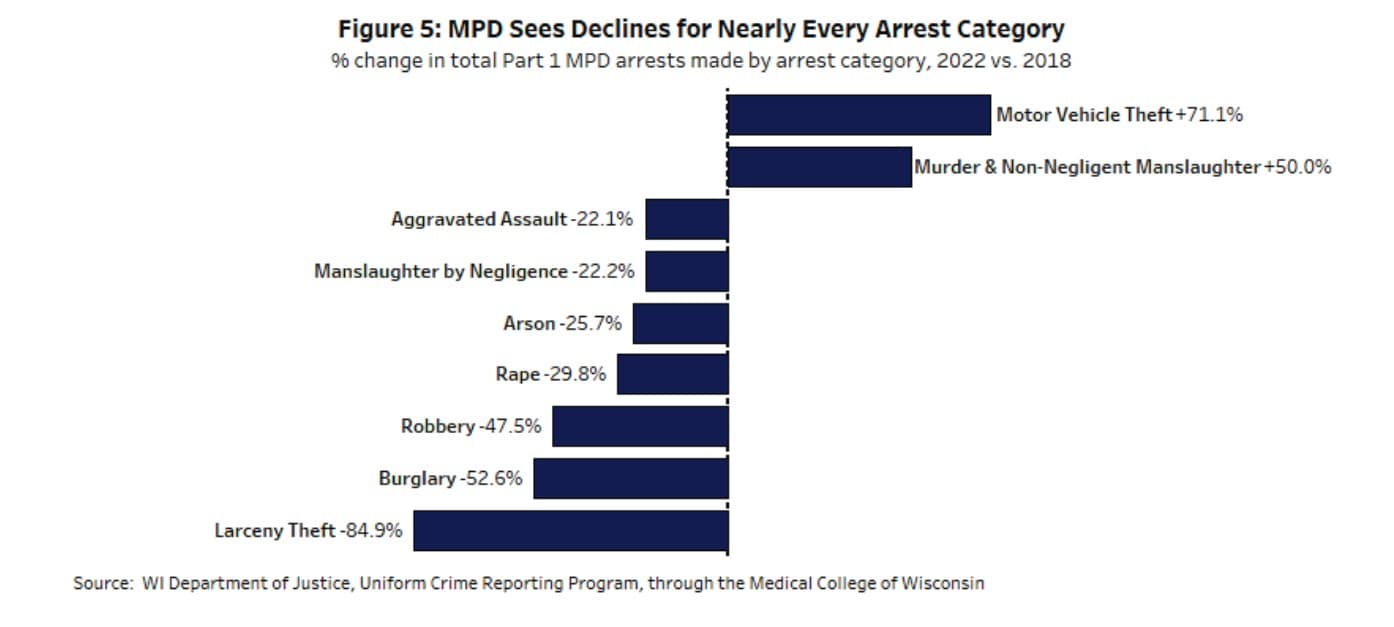
 THE SERIES:
THE SERIES:
We have taken the lead in exploring the problems in Milwaukee County’s Criminal Justice system since our site launched in 2020, breaking stories on Milwaukee police staffing declines (which started years ago), the DA’s high non-prosecution rate and new reliance on summonses, the 2018 ACLU Collins Agreement’s deleterious effect on proactive policing, new jail and police policies restricting bookings and arrests, and the massive court backlogs, which leave defendants on the streets longer to re-offend and provoke constitutional concerns. Milwaukee is at a crisis point, with record homicide numbers and a severe reckless driving crisis.
Now, a new August 2023 report from the Wisconsin Policy Forum has examined Milwaukee County’s Criminal Justice System in great detail, providing fresh data from 2018 (before the pandemic) to 2022. We are excerpting some of the key statistical findings in our 11-part series to further understanding of the problem. You can’t formulate solutions if you don’t understand the problem’s scope. The few news articles that emerged only superficially skimmed over the report’s findings. The report’s authors are Rob Henken, Ari Brown, and Betsy Mueller.
Although the report deals with the context of the pandemic, it also makes it clear that, in some respects, trends imperiling public safety started before it or have continued, even escalating in some cases, in 2022, after its height. In other words, you can’t blame everything on the pandemic. The report also indicates that, in a number of ways, some problems that escalated during the pandemic have not been resolved by officials even as late as 2022. In other cases, progress has been made.
“Overall, this report has revealed that multiple key points of the justice system pipeline in Milwaukee County are not functioning in the same way or at the same level as they were prior to the pandemic,” the authors wrote. “It is now incumbent upon justice system leaders and state and local policymakers to aggressively explore why that is, to what degree it may have impacted public safety, what progress is being made in remedying the identified challenges, and whether additional resources or other solutions are required to get the system back on track.”
In each article, which we will run over the next 11 days at 7 a.m. every day, we will outline the problems and present the research. After that, we will run a wrap-up article suggesting solutions. What happens in the state’s largest county has an effect throughout Wisconsin. The WPF report was commissioned by the Milwaukee-based Argosy Foundation and the Milwaukee Community Justice Council (CJC). Most of it is focused on useful data. In cases where we think aspects were left out, we will note that. In this series, we hope to get past simplistic rhetoric (“it’s the state Legislature’s fault!” on the left or “who cares what happens in Milwaukee!” on the right.)
PROBLEM #4: Plummeting arrests & clearance rates
Within the Uniform Crime Reporting system, crime is separated into two categories. Part 1 crimes, according to the FBI, are “serious crimes” that “occur with regularity in all areas of the country” and “are likely to be reported to the police.” These crimes include criminal homicide (all murder and manslaughter cases), forcible rape, robbery, aggravated assault, burglary, larceny theft, motor vehicle theft, and human trafficking.
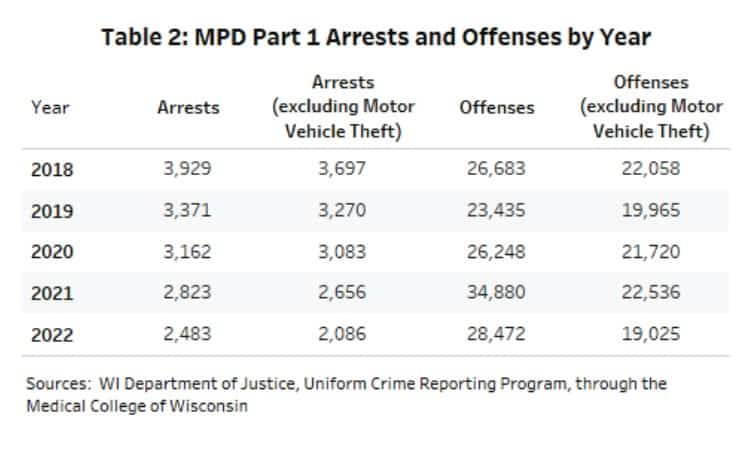
Part 2 crimes include all other offense types tracked by the UCR, including simple assault, forgery and counterfeiting, fraud and embezzlement, stolen property, vandalism, weapons, prostitution, sex offenses, drug violations, gambling, offenses against the family and children, driving under the influence, disorderly conduct, and others. While most law enforcement agencies collect arrest data on both Part 1 and Part 2 crimes, data on offenses are only reported publicly for Part 1 crimes.
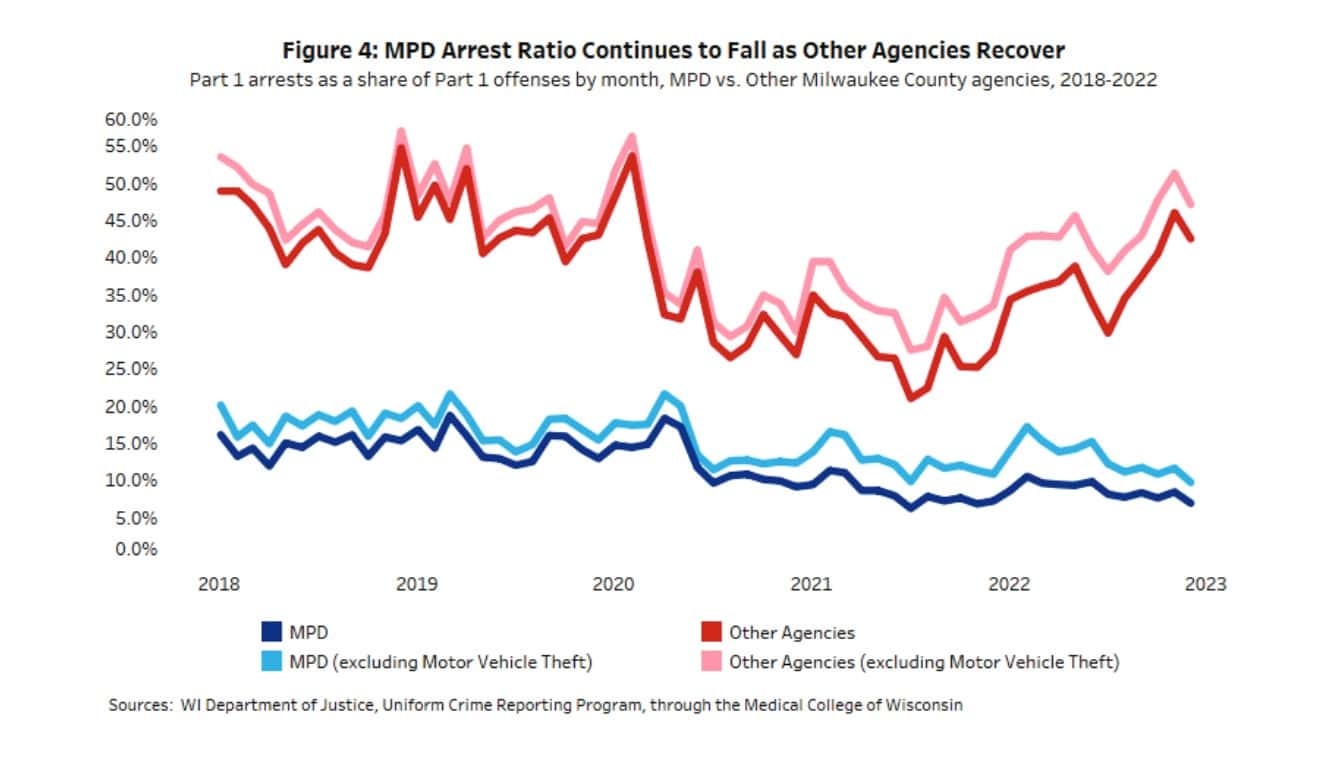
The report analyzed trends on offenses and arrests across the 21 Milwaukee County law enforcement agencies.
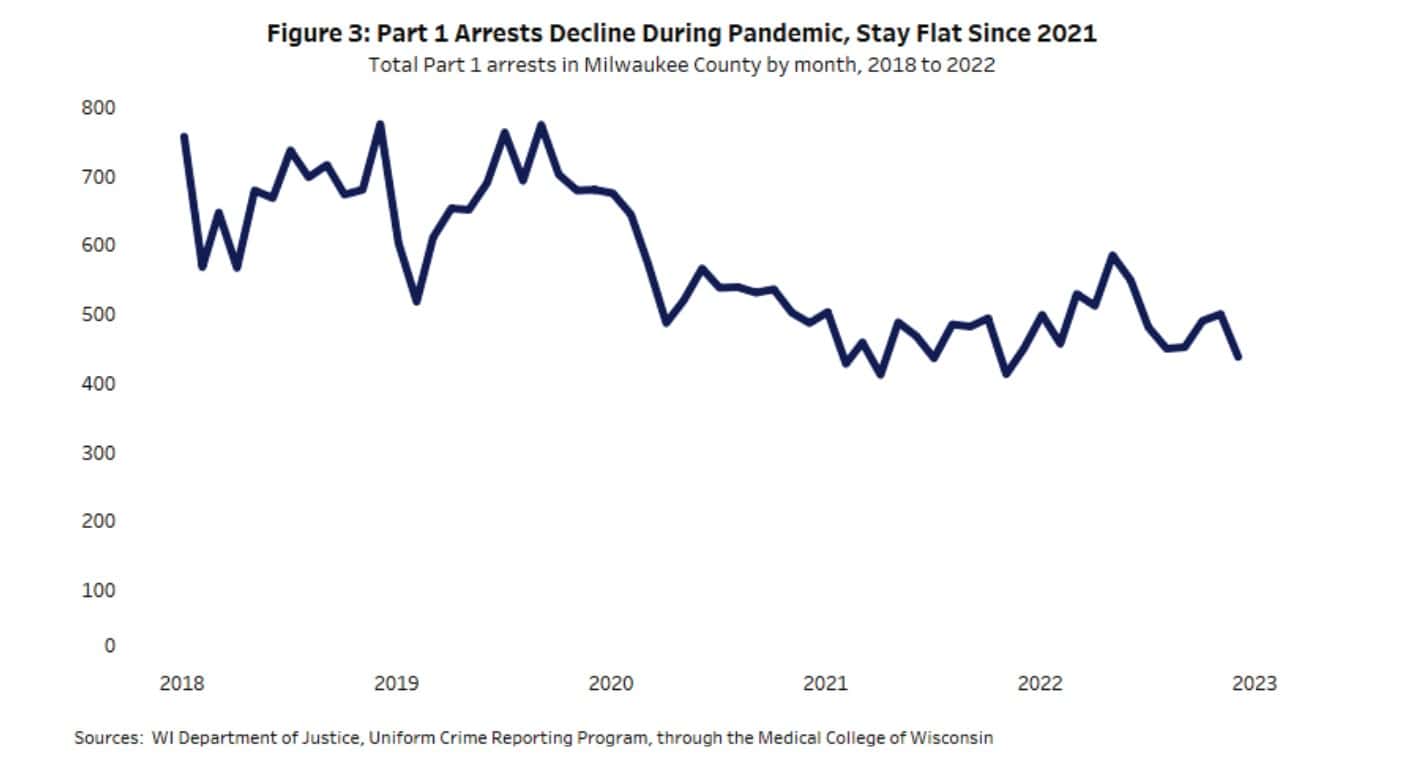
According to the report:
-
- Although serious crimes, other than motor vehicle thefts and homicides, generally stayed flat over the last five years, that’s not true of Part 1 arrests.
- In both 2018 and 2019, the 21 Milwaukee county agencies made just over 8,000 arrests for Part 1 crimes. In 2020, Part 1 arrests declined to 6,598, with a huge drop in the early months of the pandemic. However, arrest numbers have not rebounded since that time, dropping again to 5,518 in 2021 and rising only slightly to 5,942 in 2022, 27.2% below 2018 levels.
- MPD drives the numbers. Looking at just MPD, “we find that total Part 1 arrests fell at an even sharper rate than countywide, declining from 3,929 in 2018 to 2,483 in 2022 (36.8%),” the report found.
- “Another distinction when comparing MPD Part 1 arrests to those of other agencies in the county is that while arrests as a share of offenses in the suburban agencies have recovered to near pre-pandemic levels, MPD’s 2022 ratio of 8.7% was still well below the 14.4% ratio in 2019.”
- In 2018, MPD “made 935 arrests for larceny theft. That dropped to 549 in 2019, before falling to 168 in 2020 and staying below 150 in each of the two most recent years. The decline of 794 larceny theft arrests from 2018 to 2022 accounts for more than half of the total Part 1 arrest decline within MPD over those years.”
- Four crimes constitute the vast majority of Part 1 arrests: aggravated assault, larceny theft, burglary, and robbery, the report says. In each year from 2018 to 2020, “those crimes constituted more than 90% of all Part 1 arrests, while in 2022 they accounted for 85.7%. Similar to the overall Part 1 arrest trend, arrests for these four crimes dropped – from just under 7,500 in 2018 and 2019 to just over 5,000 in 2022.”
- Of these four categories, “only aggravated assault (+11.8%) saw an uptick in offenses from 2018 to 2022; arrests for the same period for that category declined by 20.7%. The drop in burglary arrests (- 46.0%) mirrors a similar drop in offenses (-48.0%). However, both larceny theft (-10.1%) and robbery (-29.1%) saw offense declines that were smaller than their arrest declines (-34.2% for larceny theft, – 38.4% for robbery).”
- The decline in larceny theft arrests is perhaps the most notable, thee report says, as it made up a majority of all Part 1 arrests in three of the last five years (2018, 2019, 2022).
- Arrests for rape “have declined in each year since 2018, from 269 in that year to 194 in 2022,” the report says.
- “Both motor vehicle theft (+66.6%) and murder & non-negligent manslaughter (+47.8%) have seen significant increases in arrests since 2018 that correspond with a concurrent rise in offenses. The other Part 1 arrest categories – arson, human trafficking, and manslaughter by negligence – generally result in very few arrests each year,” the report says.
CLEARANCE RATES
Police department “clearances” refer to offenses that – after investigation – are “cleared” “by virtue either of an arrest or, per the UCR program, by ‘exceptional means,'” the report explains.
According to the U.S. Department of Justice, exceptional means refer to “elements beyond law enforcement’s control (that) prevent the agency from arresting and formally charging the individual,” it says.
“It is important to note that a case can be cleared by one or multiple arrests. Clearance rates refer to the ratio of clearances to offenses in a given year, and we examined these rates to determine if they offered a clue into the deviation between Part I offense and arrest trends in Milwaukee County,” the authors wrote.
They found:
- In total, “22.4% of all offenses were cleared in 2018 and 24.5% in 2019, but the percentages dropped to 20.0% in 2020 and again to 16.1% in 2021, before rising to 19.5% in 2022,” the report says.
- “While the reduced clearance rates are at least partially explained by the decline in arrests, the arrest decline is much sharper than the decline in clearance rates.”
- “It is also worth noting that while the 2020 drop in clearance rates did seem to play out across most offense types, lower clearance rates in 2021 and 2022 seem to be driven by the rise in motor vehicle thefts Those offenses, in general, are cleared at a much lower rate than all other types of crime. If motor vehicle thefts are removed, then countywide Part 1 clearance rates for each of the five years of data are between 22% and 27%.”
- “Over all five years and across every department for which data are available, three Part 1 offense types have shown clearance rates above 50%: human trafficking (61.3%), manslaughter by negligence (60.4%), and murder and non-negligent manslaughter (55.2%).”
- “However, many categories in which offenses routinely total over 1,000 each year have much lower clearance rates, including aggravated assault (41.3%), robbery (26.8%), larceny theft (19.4%), burglary (9.5%), and motor vehicle theft (5.1%).”
- “No single year since 2018 has seen a clearance rate above 10% for motor vehicle thefts; in 2021, just 429 out of 14,114 cases (3.0%) were cleared. However, while the number of motor vehicle thefts decreased significantly from 2021 to 2022 (10,872), the number of cases cleared more than doubled (895), leading to a clearance rate of 8.2%, by far the highest of any year of data.”
- “MPD’s clearance rates are much lower than the other county agencies. Across all five years of data, 15.2% of all offenses were cleared by MPD, and 18.8% when not including motor vehicle thefts. Notably, the rates of clearance for burglary, larceny theft, and motor vehicle theft – which combined accounted for a majority of Part 1 offenses in 2022 – were all below 10% across the five years of data.”
- “Clearance rates for murder and non-negligent manslaughter were 67.0% in 2018 and 64.9% in 2019, but with a rise in murders dropped to 54.2% in 2020 and 45.9% in 2021, before rebounding somewhat to 50.5% in 2022.”
Part 2 crimes
- “One of our most striking findings in this report is the sharp (-61.0%) decline in Part 2 arrests in the city of Milwaukee from 2018 to 2022, despite the 26.4% increase in Part 2 offenses. In fact, every Part 2 arrest category was lower in 2022 than it was in 2018, including 13 categories that saw declines of at least 50%. The decline in Part 2 arrests in Milwaukee – from 15,142 in 2018 to 5,901 in 2022 – also greatly exceeded the notable 36.8% decrease in Part 1 arrests.”
- “There were 235 arrests for vagrancy violations in 2018, but just 14 over the last three years.”
- “There were 155 arrests for liquor law violations in 2018, compared to just one since the start of 2020.”
- MPD “made nearly 2,300 arrests for disorderly conduct in 2018, but that dropped to 872 in 2019 and has not gone above 301 since.”
- in 2018, MPD “made 3,428 arrests for simple assault – in most years, the largest Part 2
arrest category – but that has declined each year and in 2022 stood at 2,292 arrests (-33.1%).” - Weapons arrests, “which totaled over 1,100 in 2018, stood at 516 in 2022 (-53.1%). In many cases, declines are not fully attributable to the pandemic, as the largest occurred from 2018 to 2019.”
- “Indeed, MPD’s percentage decline in Part 2 arrests from 2018 to 2019 (-28.1%) was almost identical to the decline from 2019 to 2020 (-32.1%).”
- The report studied whether citations were given instead of arrests due to the pandemic and found this was not the case. MPD citations related to ordinance violations and juvenile infractions “also declined sharply during the five-year period.) Traffic citations weren’t part of that analysis.
- “A recent audit of citations conducted by the Milwaukee Comptroller found that 525 ordinance citations were not properly transmitted to the Municipal Court between January 2020 and April 2021. Those missing citations are not included in the data used for the figure but do not have a significant impact on the general trend.”
Table of Contents


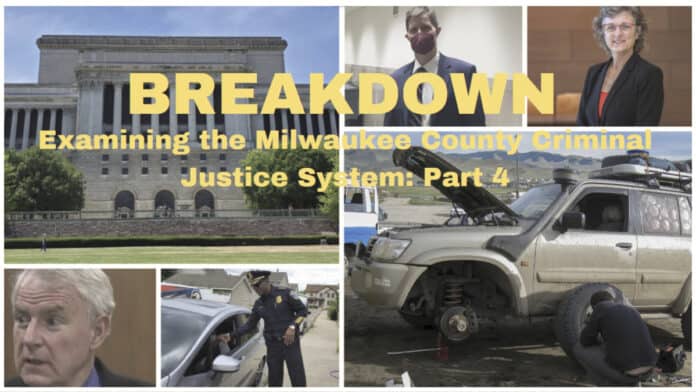
















![Mandela Barnes Said ‘Reducing Prison Populations is Now Sexy’ [VIDEO] Reducing Prison Populations is Now Sexy](https://www.wisconsinrightnow.com/wp-content/uploads/2022/09/Collage-Maker-14-Sep-2022-11.44-AM-356x220.jpg)













